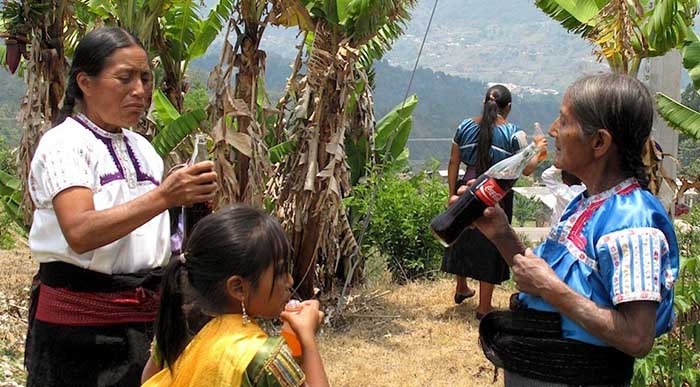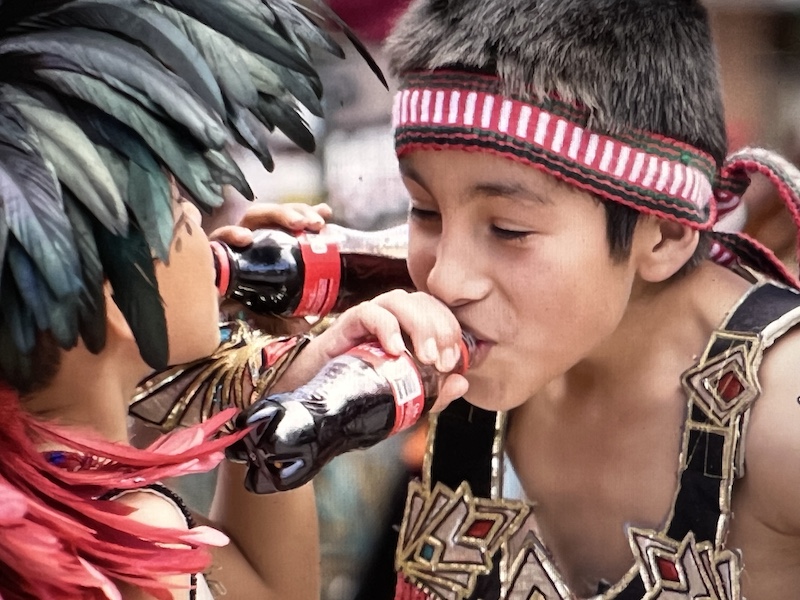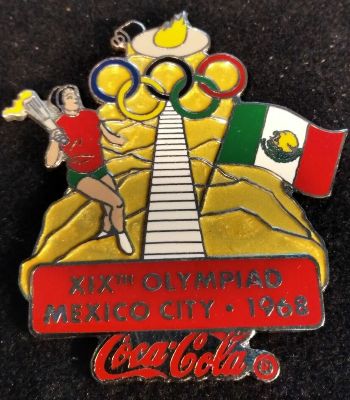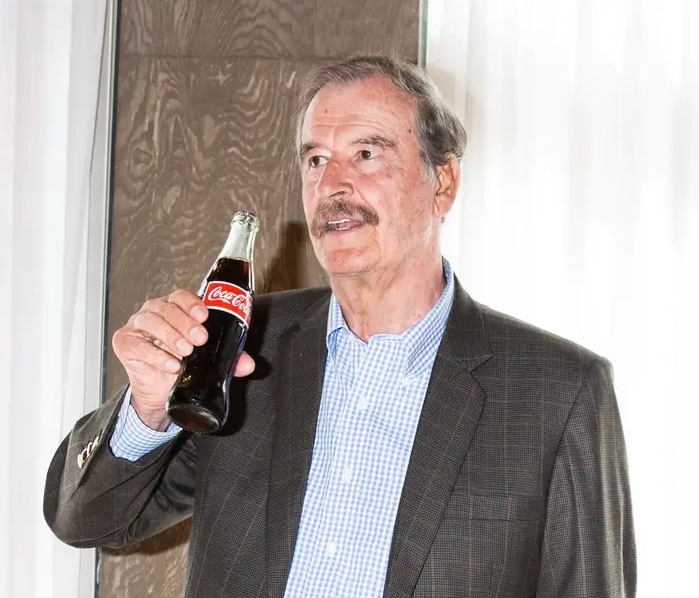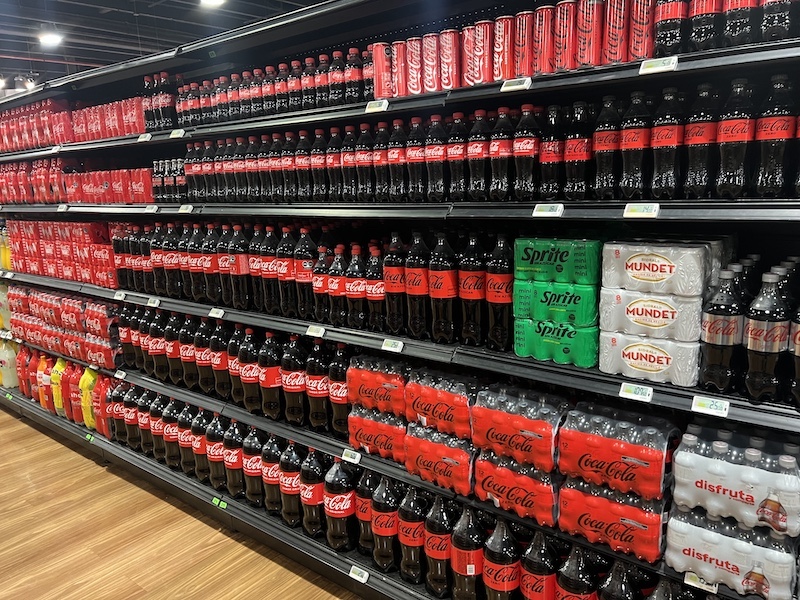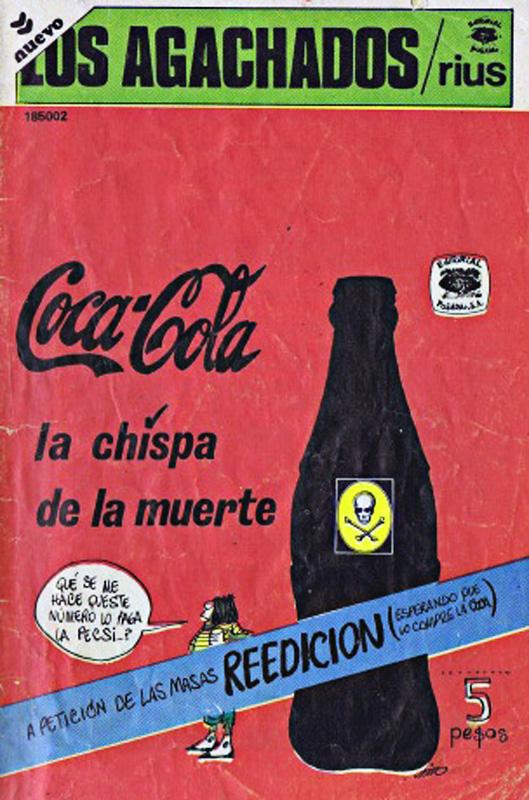|
|
The weekly newsletter of the Mexico Solidarity Project |
|
Every issue archived online at mexicosolidarityproject.org/archives/ |
|
April 23, 2025 |
|
|
|
Coke—So Popular—And So Bad for Your Health |
|
Bruce Hobson, for the editorial team |
|
|
Chiapas indigenous women |
|
. “I’d like to buy the world a coke!” said a famous Coca-Cola ad. And they've pretty much succeeded. Almost every community in every single country on the planet has Coke. In 1985, a low-budget comedy called The Coca-Cola Kid featured a corporate guru hired to get Coke into the only community in Australia where nobody had ever drunk the stuff. A comedy, yes, but it portrayed Coke’s actual strategy to saturate the planet with their addictive brew.
What makes it addictive? In 1898, when Coke began bottling in the United States, they added cocaine to Coke — and didn’t stop until 1929. From the beginning, Coke also added 34 milligrams of caffeine to each 12-ounce bottle. Stimulants like cocaine and caffeine make you feel good! Think how you feel if you don’t have your morning coffee. Coca-Cola mass-produced this affordable highly sugared drink, knowing its addictiveness would make it more successful!
It was highly successful. Globally, Coke grew into a respected pillar of capitalism, right up there with Standard Oil, selling what is nothing more than caffeinated sugar water. And in a capitalist economy, if Coke should reduce its sales for the sake of its customers’ health, that would violate its obligations to maximize shareholder profits.
In blind tests of Coke and Pepsi some years back, most people preferred Pepsi, but when the bottles were revealed, presto! People overwhelmingly went for Coke. Coca-Cola had captured brand loyalty, and it is said that in most countries, people can recognize a Coke bottle in the dark just by the feel of its shape.
But what are the health consequences of a diet of heavily sugared soft drinks? In this issue’s interview, Bruce Hobson tells us about those consequences — the epidemic of type 2 diabetes, lower leg amputations, obesity and other serious health issues in Mexico, the United States and numerous other countries. You might think twice next time you walk into 7-Eleven on a hot day. |
|
|
|
|
Coca-Cola Capitalism—It Can Make You Sick |
|
Bruce Hobson has lived and worked for decades in Mexico. He bears the distinction of being a "deportado" — deported from Mexico! After the Zapatista uprising in 1994, the Mexican government charged that his health work with Guatemalan refugees was "a front for gathering international support for the Zapatista army.” Bruce is a founder and co-coordinator of the Mexico Solidarity Project, living in Guanajuato, Mexico. He's a member of the socialist organization Liberation Road. |
|
|
When did the Coca-Cola company first introduce Coke to Mexico, and what was their strategy to get people to drink it? |
|
Coca-Cola began making Coke in 1921, over a hundred years ago. Their market strategists realized that to gain a foothold in Mexico, they’d have to understand people’s traditions. How do you enter a culture where for thousands of years people have been drinking teas, coconut milk and fruit drinks? They decided to present their strange manufactured drink slowly and somehow make it attractive to masses of people. |
|
|
Chiapas children |
|
Of course, it helped to add caffeine, cocaine and lots of sugar. Once you drank it, you wanted more. Even now, without the cocaine, it has two other addictive ingredients, caffeine and sugar.
Pepsi, Coca-Cola’s rival, eager to get in on the action, arrived in Mexico in 1929 and quickly became even more popular. It vastly outsold Coke up to the 1970s.
What then accounts for Coke, becoming the most successful drink in Mexico today? |
|
Back in the 1960s, young Coca-Cola truck driver and future president, Vicente Fox Quesada, began a personal campaign to outsell Pepsi. He once openly bragged that he’d punch the tires of Pepsi trucks and remove their bottles before they could be refilled. In a word, years before Mexico’s neoliberal period, Fox was a small-time gangster for Coca-Cola. |
|
|
Pin, Coca Cola Olympic XIXTH Olympiad Mexico City 1968 |
|
In 1968, Coca-Cola got a leg up by buying a principal sponsorship of the Mexico Olympics. It also invested in a huge advertising campaign, posting signs even in the remotest parts of Mexico. Their logo — in red with their special font — entered people’s subconscious.
Neoliberal economics sparked Coke’s next big jump in sales. In 1988, Carlos Salinas de Gortari, the newly elected president, promoted the selling off of Mexico’s natural resources and public energy industry. His negotiations with the United States and Canada culminated in the North American Free Trade Agreement, or NAFTA, allowing foreign-based companies easier penetration of the Mexican market. As a result, Coke became cheaper. |
|
In 2000, Vicente Fox, rising within the Coca-Cola company from truck driver to national director, was elected Mexico’s first president from the right-wing PAN party. Fox admitted that $7.5 million for his presidential campaign came from a Coca-Cola grant to Vision Mexico, a US-based foundation that his wife, Marta Sahagún, chaired. Vicente Fox's financial and political success was enmeshed with the Coca-Cola company — it was said he drank 12 Cokes a day. |
|
|
The Fox and the Coke |
|
|
Typical Mexican supermarket: Photo: Bruce Hobson |
|
To boot, Coca-Cola is owned by Fomento Económico Mexicano, or FEMSA, a Mexican multinational beverage and retail conglomerate. It not only operates the largest Coca-Cola bottling group in the world, but also the largest convenience store chain in Mexico, OXXO. You can find an OXXO, and Coke, on every street corner in Mexico. In rural areas, a store with a dirt floor and a wooden counter will have Coke. It’s a national staple, like corn! |
|
Mexico has serious water shortages. Does Coke production affect the availability of purified water to the population?
Almost 85% of Mexican territory is grappling with a serious water shortage, including metropolitan Mexico City, home to nearly 23 million people. Although one state in Mexico actually has sufficient water — Chiapas — one-third of Chiapas communities, largely indigenous, don’t get enough of it.
In the historic capital of Chiapas, San Cristóbal de las Casas, FEMSA has a bottling plant with rights to sell to much of Latin America. Where does the water come from? FEMSA has permits to extract 300,000 gallons of water, or 1.14 million liters, each day from the Huitepec volcano basin, with very little left to the people.
In 2022, AMLO proposed halting beer production in Northern Mexico, which requires massive amounts of water, due to severe water shortages. His proposal highlighted the issue of water scarcity and its pressure on natural resources, but it faced corporate opposition and complex legal and financial obstacles. As with beer, Coke production depends on massive amounts of water. A ridiculous argument I’ve heard is that the beer and soda industries should be applauded because they use purified water.
It’s true, the main way people can get uncontaminated water is from sugary drinks and beer. Different forms of contamination!
So, are you saying that Coke is bad? |
|
Bad doesn’t come close. As a health worker for many years in rural Mexico, I’ve seen how sugar consumption affects people’s health, particularly for poor and working families. We consume too much sugar because it’s in so many products, and sugared drinks like Coke are the most popular ones. In Mexico, as in the United States, Coke is far and away the number one soft drink, although many other brands of sugared drinks are also marketed. |
|
|
Five-year-old Coca-Cola addict |
|
Mexicans drink an average of about 32 oz. a day. I’ve seen kids walking home from the store before school carrying a liter of Coke for the family’s breakfast.
Sugared drinks are largely responsible for obesity — Mexico ranks 25th in the world for obesity levels — as well as for diabetes, heart, kidney and liver disease. Lower limb amputations due to diabetes have skyrocketed. Statistics of early deaths attributed to excessive sugar consumption are greater than deaths caused by smoking and car accidents combined.
Coca-Cola hides these facts, just as the tobacco industry hid the facts about smoking addiction for decades. What did they say? Smoking is a question of personal choice.
So, what is Mexico doing to deal with the health issues related to sugar consumption? |
|
|
"The spark of death" Rius: Coca Cola |
|
For one thing, President Claudia Sheinbaum has initiated a campaign to promote children’s health nationwide. She announced that beginning in March of this year, comida chatarra, or junk food, will be banned from sale at schools. That includes Coke and all soft drinks. This is a major positive step. But I also understand that people’s habits do not change overnight. Coke is indeed an addictive substance, and sugar and caffeine can satisfy an actual felt need.
For example, do I avoid Coca-Cola? In Mexico, my comrades and I call Coca-Cola Aguas Negras del Imperialismo Yanqui — sewer water of Yankee imperialism — and we laugh. But when we’re on a long drive, Coke keeps my eyes glued to the road and conversation going, and I love it. Now isn’t that a contradiction! |
|
|
|
|
Getting Rid of Junk Food for Children |
|
Nancy Ortiz Ochoa has been a teacher, school director, founder of a rural school and is a passionate advocate for children and youth. She has presented at numerous conferences on feminism, education, and social development. |
|
|
Something big has happened for children in Mexico this year. On March 29th, guidelines went into effect that were put forward by President Sheinbaum on the preparation, distribution and sale of food in schools throughout the country. The new guidelines prohibit the sale of so-called junk food — food that is highly processed, highly sweetened and high in fat.
Even though schools are implementing the new rules, and school programs and curricula have long recommended nutritious foods that promote health, the guidelines remain controversial. After all, neoliberal governments for years promoted junk food in schools as a quick and convenient alternative for the children, and it’s often difficult for children and their parents to change their habits.
President Sheinbaum loves children and believes that changing their eating habits is critical for their health and growth.
Recently, some children who were upset demanded that President Sheinbaum explain why their schools had removed comida chatarra. Their complaint is actually understandable. Junk foods can produce a feeling of well-being and satisfaction because they stimulate the production of dopamine, a neurotransmitter that produces pleasure, relaxation and a sense of well-being. Which is to say, these “foods” are actually addictive.
But “quick and convenient” foods have been harmful to the nation’s health. Decades of poor nutrition have generated high rates of obesity and diabetes, including among children. We hope Dr. Claudia Sheinbaum continues to implement the new measures and that the schools find healthful, affordable and easy-to-prepare food for all their children. |
|
|
|
Recent news reports and commentaries, from progressive and mainstream media, |
|
Natascha Elena Uhlmann, Unmoved by Tariff Threats, Mexican GM Workers Win a Double-Digit Wage Hike Labor Notes. In spite of the company's efforts to stoke uncertainty, auto workers stood their ground, garnering wage increases of 10 percent on average.
Gobierno de Ecuador alerta por presunto traslado de sicarios desde México para atentar contra Noboa El Financiero. Esto es, por supuesto, una ilusión para producir más conflicto entre México y Ecuador en beneficio del imperialismo estadounidense.
Carlos Camacho, El PT tensa la cuerda con Morena La Jornada Hidalgo. Ya se irá viendo si la estrategia del PT es la adecuada y logra convertirse en “la primera fuerza política de Hidalgo” o sucumba ante la acometida del partido en el poder.
Mexico Not To Resume Diplomatic Relations With Ecuador Telesur English. President Sheinbaum described Daniel Noboa’s victory in the presidential elections as ‘dubious.’
Alejandro De la Garza, Corporativos hoteleros: dueños de playas, aguas y tierras Sin Embargo. Los grandes corporativos hoteleros han significado la apropiación de tierras ejidales o comunales mediante diversas presiones.
Carlos Fazio, Marco Rubio’s Dirty Laundry Resumen. According to reports in the South Florida media, the IRS and the Department of Justice have received information from a source at CITGO linking Rubio and his old friend and political ally, former Cuban-American Congressman David Rivera, to corruption associated with a corporation. However, influential Republicans in Florida have blocked the investigation
Viri Ríos, Mi evaluación de candidatas a ministras (boleta morada) Milenio. Una ministra progresista protege el interés público frente a privilegios corporativos y prioriza la igualdad sustantiva por encima de la mera igualdad formal.
Héctor Ríos Morales, Fentanyl Trafficking Is Down Almost Two Thirds Since As Mexican President Strengthens Relation With Trump Latin Times. Among the most notable operations by Mexican and American authorities was the seizure of 2,410 pounds of fentanyl in February, the largest such bust in the country's history. Authorities said the shipment had an estimated value of $400 million.
Zósimo Camacho, México ha perdido 4.77 millones de hectáreas de bosque en dos décadas Diario Red. El promedio anual de deforestación del país, entre 2001 y 2023, es de 207 mil 665 hectáreas, con tendencia a la baja. Privatización de la propiedad social, ganadería, agricultura industrial y urbanización, principales causas. |
|
|
|
|
The Mexico Solidarity Project brings together activists from various socialist and left organizations and individuals committed to worker and global justice. We see the 2018 election of Andrés Manuel López Obrador as president of Mexico as a watershed moment. AMLO and his progressive Morena party aim to end generations of corruption, impoverishment, and subservience to US interests. Our Project supports not just Morena, but all Mexicans struggling for basic rights, and opposes US efforts to undermine organizing and Mexico’s national sovereignty.
Editorial committee: Meizhu Lui, Bruce Hobson, Agatha Hinman, Victoria Hamlin, Courtney Childs, Pedro Gellert. To give feedback or get involved yourself, please email us! |
|
Subscribe! Get the Mexico Solidarity Bulletin in your email box every week. |
|
Web page and application support for the Mexico Solidarity Project from NOVA Web Development, a democratically run, worker-owned and operated cooperative focused on developing free software tools for progressive organizations. |

